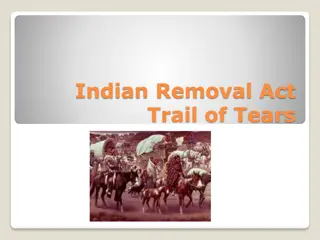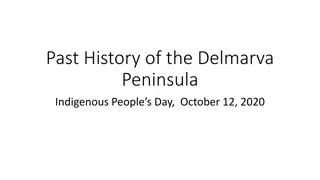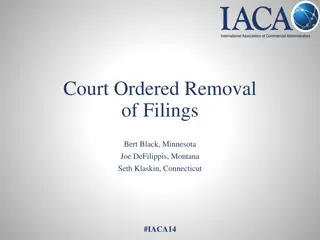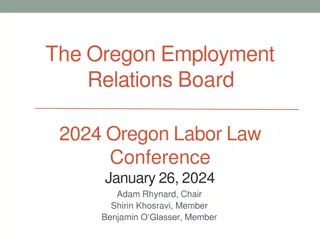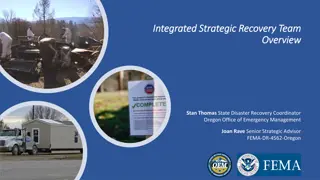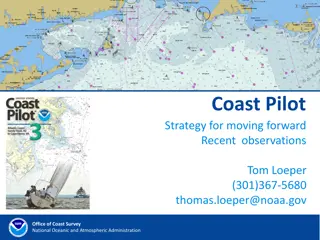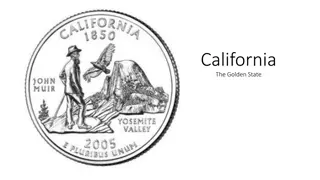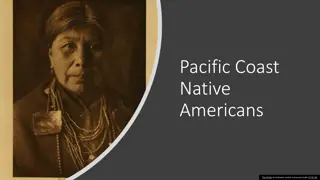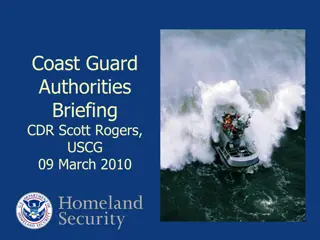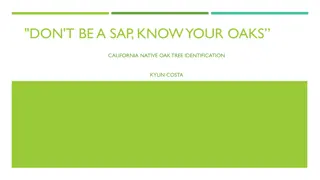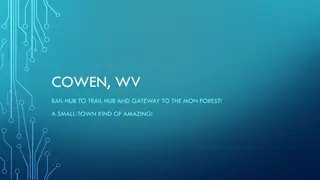Trail of Tears Forced Removal from Oregon and California Coast
Joel Palmer and Federal Indian Policy oversaw the forced removal of Native peoples from Rogue River Valley and southern Oregon/northern California coast to the Siletz Coast Reservation between 1856-1860. The brutal journeys, including the First Removals in January 1856 and the harrowing Journey from Table Rock in February 1856, highlight the tragic events and hardships faced by Indigenous tribes during this period. The Removals by Sea in June 1856 marked the largest removal from Southern Oregon, driven by the urgency to protect Native populations from further violence and extermination by settlers and miners.
Download Presentation

Please find below an Image/Link to download the presentation.
The content on the website is provided AS IS for your information and personal use only. It may not be sold, licensed, or shared on other websites without obtaining consent from the author. Download presentation by click this link. If you encounter any issues during the download, it is possible that the publisher has removed the file from their server.
E N D
Presentation Transcript
GRADE 8 | LESSON 3 | WAR AND REMOVAL Trails of Tears Walk on and don t look back
Joel Palmer and Federal Indian Policy: Forced Removal Forced removal of Native peoples from the Rogue River Valley and southern Oregon/northern California coast to the Siletz Coast Reservation 4,000 Native people removed to the reservation between 1856 1860 Two different narratives, or stories, about the forced relocation and resettlement
First Removals January 1856 The first removals forced members of the Kalapuya, Molalla, and Umpqua Tribes from their homes in the Willamette Valley and on the Umpqua Reservation. The trails went overland to a temporary camp established at Grand Ronde to hold survivors until the Siletz Coast Reservation was operational. After tense days of refusal, Umpqua Tribal leaders agreed to leave their temporary reservation in their homelands. Settlers circulated among the Umpqua Tribe, threatening that they would be shot when they arrived at Grand Ronde. One missing man was found murdered during the trip. Heavy rains blocked the roads, and so many people were too sick to walk that government agents worried they would not have enough wagons to carry people.
The Journey from Table Rock February 23, 1856 Toquahear and 400 Taklema, Shasta, and Upper Rogue Athabaskan people were forced to march from Fort Lane (on the Table Rock Reservation near present-day Medford) to the temporary camp at Grand Ronde. The trail followed the existing California-Oregon Trail (now Interstate 5) from Table Rock to the Willamette Valley. An army escort guarded the train, less to prevent the sick and desperate marchers from rejoining the war than to protect them from armed bands of settler "volunteers" who government agents feared would shoot the group. Despite the military escort, white vigilantes stalked and terrorized the people during the trip, murdering one man. The journey took 33 days to go 263 miles. Eight people died and eight babies were born along the way.
The Removals by Sea June 21, 1856 After the Rogue River War ended, the U.S. Army rounded up Native people at Big Bend on the Rogue River and marched them 50 miles to the military fort at Port Orford. More than 600 Native people were put aboard the steamer ship Columbia, shipped to Portland, and then taken on a smaller ship to a place near Dayton. They were then marched on foot to Grand Ronde and eventually the Siletz Coast Reservation. This was the largest removal of people from Southern Oregon. Federal officials claimed urgency, saying that miners and settlers would continue their war of extermination if all Native people weren't removed from the region.
The Removals by Sea (Continued) Oregon Superintendent of Indian Affairs Joel Palmer made the journey with the first group on the steamship Columbia. When these groups arrived near present-day Lincoln City, they were the first to reach the Coast Reservation; however, it was still a long march to the final location of the agency headquarters at Siletz.
Second Voyage by Sea July 1856 Another voyage of the Columbia steamship took more Lower Rogue River people and the bands of Cholcultah (Tyee George) and Lympy Tyee along the same route as the first journey. Many Native people didn't trust the government and feared that they would be taken out to sea and drowned. Superintendent Palmer tried to calm their fears by returning with a few young men from the first trip to prove that the first group had survived the voyage. Altogether, more than 1,400 people were moved from Port Orford by sea. Once the coast group arrived at Grand Ronde, the temporary camp became the largest population center in the entire state (bigger than Portland, Salem, or Jacksonville were at the time).
The Death March July 1856 125 people from Tyee John s (Tecumtum) band, along with people from the Pistol and Chetco Rivers, were marched north from Port Orford by a group of 90 soldiers. The route went along the coast over difficult terrain that lacked roads and bridges. Superintendent Palmer and army officials chose the slower and more difficult route to punish Tyee John and other leaders for fighting to remain in their homeland.
Reservation Not Ready for the People Federal officials started removal before establishing the infrastructure that was necessary to support people on the Siletz Coast Reservation. Had not prepared homes or agency buildings, as promised in treaties Had not developed roads or plans for providing food and supplies Had to establish a temporary camp at Grand Ronde As a result, the government was chronically unprepared to ensure the health and safety of people removed to the reservation. Uprooted from their ways of living, Native people required food support to avoid starvation. Indian agents operated with little direct oversight and purchased inadequate supplies at inflated prices, likely in exchange for bribes.
1855 Coast Treaty Review: Unratified If the Coast Treaty of 1855 had been ratified, it would have created a smaller Siletz Reservation. Instead, three days before the Coast Treaty arrived in Washington, D.C., President Pierce acted on Superintendent Palmer s April 1855 request for the 1.1 million-acre Siletz Reservation. Once the Tribes were forcibly removed and under military guard on the reservation, the U.S. Senate refused to act on the Coast Treaty. Because the treaty was not ratified, Congress never authorized the supplies that had been promised as payment to the Tribes who were removed to the reservation. Native people were treated as prisoners on the reservation. There was not enough money to provide everyone with food or shelter, creating devastating conditions of disease and hunger.
Central Coast Peoples Late summer 1856 The Hanis and Miluk peoples, who had been kept as prisoners near the town of Empire since the outbreak of the Rogue River War, were marched up the coast to the new army post at Fort Umpqua, joining the Lower Umpqua (Quuitch) people. Just south of the boundary of the Siletz Coast Reservation, Fort Umpqua was established to maintain order and prevent people from fleeing the reservation. In 1860, the Hanis and Miluk peoples would be forcibly removed north onto the reservation.
The Long Tail of Removal August 1856 The first groups arrived at the ultimate headquarters of the Siletz Coast Reservation, a prairie on the Siletz River (the present-day town of Siletz). Salmon River (Neachesna), Siletz, Yaquina, Alsea, and Siuslaw peoples saw the reservation created on their ancestral territories. Although they remained in their ancestral home, they were forced to share their homelands with thousands of newcomers without compensation. Many of these Tribes suffered their own heartbreaking removals in years to come as the government reduced the size of the reservation. Some Native people of Southern Oregon managed to escape removal by hiding, or they later fled the reservation and attempted to return to their homelands. They were brutally rounded up by vigilantes, soldiers, and federal officials well into the 1860s. Despite removal, today many Siletz families maintain ties to their ancestral homelands across Western Oregon and Northern California.
Stories There was no fully common experience, no single story, for the thousands of removed western Oregon Indians. The faces at the Grand Ronde gathering surely reflected that. Many endured serious physical injuries and disease, for the European germs continued to exact their tolls. Others including women and children who had witnessed the brutal battles on the Rogue suffered from what we now know as post-traumatic stress disorder. Sadness must have shown everywhere. Wilkinson, 2010, p. 160 Wilkinson, C. (2010). The people are dancing again: The history of the Siletz Tribe of Western Oregon. University of Washington Press.
The Danger of a Single Story What kinds of stories do we tell? Stock story Concealed story
Stock Story (Example) After the Rogue River War, Native survivors were sent by steamboat from Port Orford to Portland and then on to the Grand Ronde encampment. (There was no Grand Ronde Reservation until June 1857.) Tecumtum and his followers surrendered and made the journey on foot. Even after this journey, many were moved to the mouth of the Salmon River on the coast and subsequently to the Siletz Agency on the Siletz Coast Reservation.
Concealed Story (Example) Our trail of tears began. Ki-Ya-Na-Ha was not one of the ones that rode on the ship or a wagon, for she remembers walking most of the way. She told of women being abused, misused, and even kicked around by the white soldiers, especially if a mother tried to protect her young daughters. If men came to the rescue of their families, they were badly beaten and in some cases shot, and left, for they were not allowed to stop and bury anyone that died along the way. She also remembered little children being kicked around if they fell too far behind. Pauline Bell Ricks [Testifying before the Senate Subcommittee on Indian Affairs, March 30, 1976]
Concealed Story (Continued) ... But Ki-Ya-Na-Ha was a strong-willed woman and soon she adjusted. But her sister did not. She made up her mind that she would go back to the Rogue River and live out her days there. She was very unhappy in Siletz, so she left and went back to the Rogue River to die." Ki-Ya-Na-Ha continued on at Siletz, married, and raised children. "She remembered the long walk to Kings Valley to pack sacks of flour on their backs. Sometimes women made these trips and packed hundreds of pounds of flour on their backs, chanting sometimes a monotonous tune and sometimes a melancholy tune; for as the saying goes today, 'Sometimes we have to laugh to keep from crying.' Pauline Bell Ricks [Testifying before the Senate Subcommittee on Indian Affairs, March 30, 1976]
Discussion Question What differences do you notice between these two stories of the forced removal of Native Americans in Western Oregon?
Timeline Activity Continued Step 1. Move into groups of 4 5 Step 2. Assign group roles Facilitator: Ensures that the group stays on task and that everyone participates Recorder: Writes the title of the key event and a written summary or visual on index cards to post on the classroom timeline Presenter: Shares the group s ideas with the rest of the class and posts key event(s) on timeline Questioner: Seeks assistance from either the teacher or another group if needed Step 3. What important events do we need to add to the timeline?
Timeline Reflection Questions At what other points on the timeline might there be concealed stories? We've seen one example of an Indigenous person telling their experience of removal. At what other points on the timeline would hearing from a Native perspective change the way you understand the events?
Reflection/Closure Exit ticket. Respond to the following reflection questions: How does knowing these events change the way you think about the history of Oregon? How does learning about these events change the way you think about the future of Oregon?


